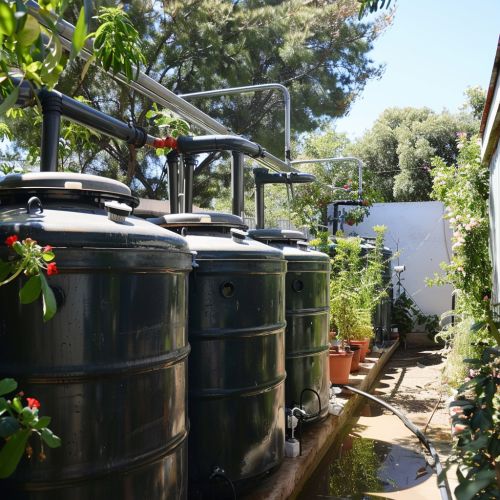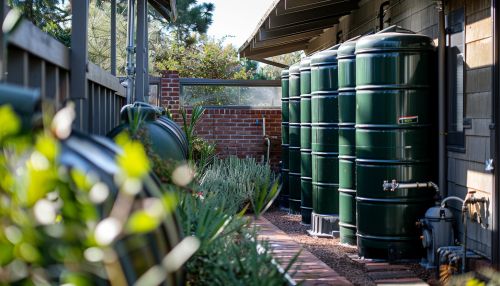Greywater Systems: Difference between revisions
(Created page with "== Introduction == Greywater systems are an essential component of sustainable water management strategies. These systems are designed to collect, treat, and reuse greywater, which is wastewater generated from domestic activities such as bathing, laundry, and dishwashing. Unlike blackwater, which contains human waste, greywater is relatively clean and can be repurposed for various non-potable uses, thereby reducing the demand for fresh water and minimizin...") |
No edit summary |
||
| Line 19: | Line 19: | ||
Pumped systems use mechanical pumps to move greywater through the treatment process and to the point of reuse. These systems are more complex and can handle larger volumes of greywater. They often incorporate advanced treatment technologies such as membrane bioreactors, ultraviolet (UV) disinfection, and chemical treatment to ensure the greywater meets specific quality standards. | Pumped systems use mechanical pumps to move greywater through the treatment process and to the point of reuse. These systems are more complex and can handle larger volumes of greywater. They often incorporate advanced treatment technologies such as membrane bioreactors, ultraviolet (UV) disinfection, and chemical treatment to ensure the greywater meets specific quality standards. | ||
[[Image:Detail-91483.jpg|thumb|center|Residential greywater system with tanks and pipes for water recycling.|class=only_on_mobile]] | |||
[[Image:Detail-91484.jpg|thumb|center|Residential greywater system with tanks and pipes for water recycling.|class=only_on_desktop]] | |||
== Components of Greywater Systems == | == Components of Greywater Systems == | ||
Latest revision as of 01:41, 21 June 2024
Introduction
Greywater systems are an essential component of sustainable water management strategies. These systems are designed to collect, treat, and reuse greywater, which is wastewater generated from domestic activities such as bathing, laundry, and dishwashing. Unlike blackwater, which contains human waste, greywater is relatively clean and can be repurposed for various non-potable uses, thereby reducing the demand for fresh water and minimizing the environmental impact of wastewater disposal.
Types of Greywater Systems
Greywater systems can be broadly categorized into three types: direct reuse systems, gravity-fed systems, and pumped systems.
Direct Reuse Systems
Direct reuse systems are the simplest form of greywater systems. They involve the immediate use of greywater for applications such as garden irrigation without significant treatment. These systems typically include a basic filtration mechanism to remove large particles and debris.
Gravity-Fed Systems
Gravity-fed systems rely on the natural force of gravity to transport greywater from the source to the treatment and reuse areas. These systems often include multiple stages of filtration and treatment, such as sedimentation tanks, sand filters, and biological treatment units. Gravity-fed systems are advantageous because they do not require energy for pumping, making them more sustainable and cost-effective.
Pumped Systems
Pumped systems use mechanical pumps to move greywater through the treatment process and to the point of reuse. These systems are more complex and can handle larger volumes of greywater. They often incorporate advanced treatment technologies such as membrane bioreactors, ultraviolet (UV) disinfection, and chemical treatment to ensure the greywater meets specific quality standards.


Components of Greywater Systems
Greywater systems consist of several key components, each playing a crucial role in the collection, treatment, and distribution of greywater.
Collection
The collection component involves capturing greywater from various sources within a household or commercial building. This is typically achieved through a network of pipes that divert greywater from sinks, showers, and washing machines to a central collection point.
Filtration
Filtration is a critical step in greywater treatment. It involves removing solid particles and debris from the greywater to prevent clogging and ensure the efficiency of subsequent treatment stages. Common filtration methods include coarse screens, sand filters, and cartridge filters.
Biological Treatment
Biological treatment processes use microorganisms to break down organic matter in greywater. This can be achieved through systems such as constructed wetlands, aerobic bioreactors, and anaerobic digesters. Biological treatment is effective in reducing the biochemical oxygen demand (BOD) and total suspended solids (TSS) in greywater.
Disinfection
Disinfection is the final treatment step, aimed at eliminating pathogenic microorganisms to ensure the greywater is safe for reuse. Common disinfection methods include chlorination, UV irradiation, and ozonation. The choice of disinfection method depends on the intended reuse application and the required water quality standards.
Distribution
The distribution component involves delivering treated greywater to the point of use. This can include irrigation systems, toilet flushing systems, and other non-potable applications. Distribution systems must be designed to prevent cross-contamination with potable water supplies and ensure the safe and efficient use of greywater.
Benefits of Greywater Systems
Greywater systems offer numerous environmental, economic, and social benefits.
Environmental Benefits
Greywater reuse reduces the demand for fresh water, thereby conserving valuable water resources. It also decreases the volume of wastewater discharged into the environment, reducing the load on sewage treatment plants and minimizing the risk of water pollution. Additionally, greywater irrigation can enhance soil fertility and support plant growth by providing essential nutrients.
Economic Benefits
Implementing greywater systems can lead to significant cost savings by reducing water bills and lowering the expenses associated with wastewater treatment and disposal. In regions with water scarcity, greywater reuse can provide a reliable alternative water source, reducing the need for expensive water imports or desalination.
Social Benefits
Greywater systems promote sustainable water management practices and raise awareness about the importance of water conservation. They can also improve the resilience of communities by providing an alternative water supply during droughts or water shortages.
Challenges and Considerations
Despite their benefits, greywater systems face several challenges and considerations that must be addressed to ensure their successful implementation.
Water Quality
The quality of greywater can vary significantly depending on the source and household practices. Contaminants such as soap, detergents, and personal care products can affect the treatment process and the suitability of greywater for reuse. It is essential to monitor and manage greywater quality to prevent potential health risks and environmental impacts.
Regulatory Framework
The implementation of greywater systems is subject to local regulations and guidelines, which can vary widely between regions. These regulations may dictate the design, operation, and maintenance of greywater systems, as well as the permissible uses of treated greywater. Compliance with regulatory requirements is crucial to ensure the safety and legality of greywater reuse.
System Maintenance
Regular maintenance is essential to ensure the efficiency and longevity of greywater systems. This includes routine inspection and cleaning of filters, pumps, and treatment units, as well as monitoring water quality and system performance. Proper maintenance can prevent system failures and ensure the consistent production of high-quality greywater.
Public Perception
Public perception and acceptance of greywater reuse can influence the adoption of greywater systems. Education and outreach efforts are necessary to inform the public about the benefits and safety of greywater reuse and to address any concerns or misconceptions.
Case Studies
Several successful case studies highlight the potential of greywater systems to contribute to sustainable water management.
Residential Greywater Systems
In residential settings, greywater systems have been implemented to reduce water consumption and support garden irrigation. For example, a study in California demonstrated that households using greywater systems for landscape irrigation reduced their potable water use by up to 40%. These systems typically include simple filtration units and gravity-fed distribution networks.
Commercial Greywater Systems
Commercial buildings, such as hotels and office complexes, have adopted greywater systems to manage large volumes of wastewater and reduce operational costs. One notable example is the greywater system installed at the Sydney Olympic Park, which treats and reuses greywater for toilet flushing and irrigation. This system incorporates advanced treatment technologies, including membrane bioreactors and UV disinfection, to ensure high-quality greywater.
Community-Scale Greywater Systems
Community-scale greywater systems have been implemented in various regions to address water scarcity and support sustainable development. In Jordan, a pilot project demonstrated the feasibility of using greywater for agricultural irrigation in rural communities. The project involved the construction of decentralized greywater treatment units, which provided a reliable water source for crop production and improved the livelihoods of local farmers.
Future Prospects
The future of greywater systems is promising, with ongoing research and technological advancements driving innovation in this field.
Technological Innovations
Emerging technologies, such as advanced oxidation processes, nanofiltration, and electrochemical treatment, hold the potential to enhance the efficiency and effectiveness of greywater treatment. These innovations can improve the removal of contaminants and pathogens, enabling the safe reuse of greywater for a broader range of applications.
Integration with Smart Water Management
The integration of greywater systems with smart water management technologies can optimize the operation and monitoring of these systems. Smart sensors, data analytics, and automated controls can enhance the efficiency, reliability, and user-friendliness of greywater systems, making them more accessible and attractive to users.
Policy and Regulation
The development of supportive policies and regulations can facilitate the widespread adoption of greywater systems. Governments and regulatory bodies can play a crucial role in promoting greywater reuse by providing incentives, establishing clear guidelines, and raising public awareness about the benefits of greywater systems.
Conclusion
Greywater systems represent a viable and sustainable solution for addressing water scarcity and reducing the environmental impact of wastewater disposal. By harnessing the potential of greywater reuse, communities can conserve water resources, reduce costs, and promote sustainable water management practices. Continued research, innovation, and supportive policies are essential to realizing the full potential of greywater systems and ensuring their successful implementation.
